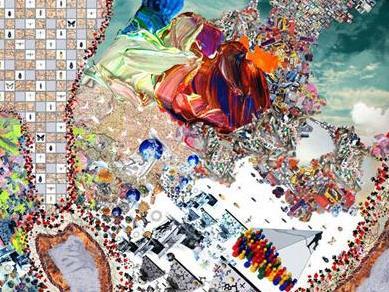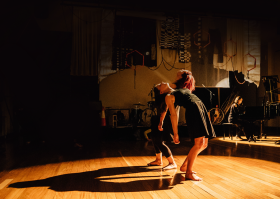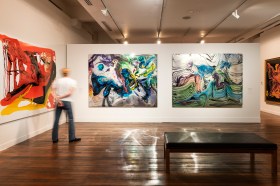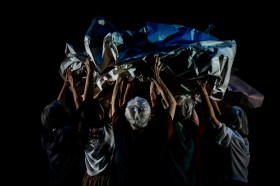Image: Jacob Leary, Laughter of the Height, Despard Gallery
The Australia Council figures released last week showed Tasmania receives a disproportionate slice of funding. So it should.
Since the beginning of time, humans have created art. In many societies it was seen as a spiritual act as well as an act of personal expression, status, power and tribal connections; it was a way of expressing identity – individually and collectively.
Many look only to the outcome of the artistic process; the finished goods, which may be beautiful, terrible, awesome, provocative, evocative, ‘cool’ or simply nice to have around.
But outcome is just one way to engage in art. The consumer of the finished product interacts each in their own way and for their own purpose; decoration, status, enhancement in whatever way, power…. and richness is gained. The consumer has their needs met, hopefully so too does the artist.
Art is infinitely more than its subjective outcome. It is a process; a tangible and intangible creative process which can engage both artist and a greater public. It is proven to be immensely valuable as a tool for healing both on a personal and collective level as many examples illuminate. The arts have the power to heal broken hearts, broken people and broken communities; to congregate, yes, even galvanise where fragmentation once existed.
The arts can create community pride and build social capital, subtle and imperative values within a society which morph into wellbeing, lifestyle and a sense of belonging, intrinsic values which can translate to hardcore economic realities.
We are born artists; designers and creators of our own lives. Art resides in our entelechy, but our western ways tend to diminish its relevance in favour of mere economics. However, art and its expression is in that very process; the act of creation, of giving form to the formless and making it tangible. So too is this a core function of economics.
Without a creative progression, businesses would not emerge, new products and technologies would not see the light of day. Creativity is the core element of innovation and entrepreneurism, of building social capital, of promoting strong, cohesive, vibrant communities and of edifying a collective and individual resilience. The artistic process fosters creativity and in whatever expression it manifests it is what is imperative to be supported for this is as much the way of the future as it was of the past. The ‘Clever Country’…. how can we be clever without creativity? Artistic expression cultivates creativity in its purist form.
In Tasmania and, in particular the North West of Tasmania, support for the arts is vital. Not to provide it would be to diminish an already challenged region – a region that is in a number of ways behind the proverbial eight ball. We face many challenges: physical location as an island; our North West region’s situation as a ‘disadvantaged’ area; low levels of higher education; high unemployment; high teen pregnancies and social dysfunction; an aged population and cultural impoverishment.
Art empowers. There are a myriad of examples where this can be demonstrated and there are statistics to substantiate them; on individual and collective levels. Funding dollars go some small way to support artists to bring communities together, support cross-generational interaction which aid social cohesion and wellbeing, empower the powerless, educate the unlearned, encourage small enterprises which aids their self-sustainability and reduced reliance on government handouts. The arts go a long way to create economic benefits which have far-reaching flow-on effects to the communities, town and cities that allow them to emerge.
Funding the arts in this region could well be, indeed is becoming, a key strategy in a brighter future for our area, one of which we can be proud, and one which is sustainable long after other resources have been dug up, exhausted or are no longer relevant.
As Tasmania has the oldest demographic population, the largest per capita involvement in the arts at 1:4, surely leveraging this would be a high priority on a governmental future-focused agenda. Building the arts, which develops and forges relationships and resources-sharing and therefore builds communities should be intrinsic to a regional development policy at both State and National level.
The Age of Enlightenment saw great outpourings of art and culture, the legacy of which informs the very fabric of today’s society. Without patronage, these forebears would not have survived and art would have been reduced to a discretionary or perhaps even a subversive act.
The ‘MONA effect’ is the supreme contemporary example of this as it has, in a very short time, elevated Tasmania and specifically, Hobart to an internationally famous, ‘must see’ destination. Why does it take one person’s private vision and resources to achieve what large public organisations and governments with all their resources do not seem to be able to do? Mona, in its short history, has singlehandedly created more tourist interest, which converts to greater economic benefits, than other tourist icons ever did in the same period.
Not to fund arts in this region would be negligent. It would diminish what could be our own Tasmanian Age of Enlightenmen..
What sort of society do we want to live in and do we want our children’s children to inherit? I for one want mine to know they have a tacit permission as their human right to find artistic expression in culturally rich ways and to be supported by a liberal society to do so.





